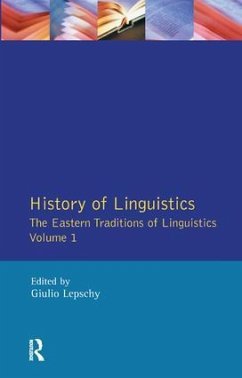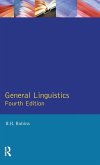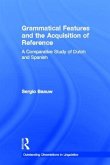- Gebundenes Buch
- Merkliste
- Auf die Merkliste
- Bewerten Bewerten
- Teilen
- Produkt teilen
- Produkterinnerung
- Produkterinnerung
First Published in 1994. Routledge is an imprint of Taylor & Francis, an informa company.
Andere Kunden interessierten sich auch für
![Language for Life Language for Life]() Lyn StoneLanguage for Life179,99 €
Lyn StoneLanguage for Life179,99 €![General Linguistics General Linguistics]() R H RobinsGeneral Linguistics180,99 €
R H RobinsGeneral Linguistics180,99 €![The Routledge Companion to English Language Studies The Routledge Companion to English Language Studies]() Janet MaybinThe Routledge Companion to English Language Studies155,99 €
Janet MaybinThe Routledge Companion to English Language Studies155,99 €![Grammatical Features and the Acquisition of Reference Grammatical Features and the Acquisition of Reference]() Sergio BaauwGrammatical Features and the Acquisition of Reference180,99 €
Sergio BaauwGrammatical Features and the Acquisition of Reference180,99 €![The Inflected Infinitive in Romance Languages The Inflected Infinitive in Romance Languages]() Emily E ScidaThe Inflected Infinitive in Romance Languages180,99 €
Emily E ScidaThe Inflected Infinitive in Romance Languages180,99 €![Phonology in English Language Teaching Phonology in English Language Teaching]() Martha C PenningtonPhonology in English Language Teaching157,99 €
Martha C PenningtonPhonology in English Language Teaching157,99 €![The Language of Gaze The Language of Gaze]() Isabella PoggiThe Language of Gaze179,99 €
Isabella PoggiThe Language of Gaze179,99 €-
-
-
First Published in 1994. Routledge is an imprint of Taylor & Francis, an informa company.
Hinweis: Dieser Artikel kann nur an eine deutsche Lieferadresse ausgeliefert werden.
Hinweis: Dieser Artikel kann nur an eine deutsche Lieferadresse ausgeliefert werden.
Produktdetails
- Produktdetails
- Verlag: Taylor & Francis
- Seitenzahl: 224
- Erscheinungstermin: 27. Februar 2017
- Englisch
- Abmessung: 216mm x 140mm x 14mm
- Gewicht: 408g
- ISBN-13: 9781138158832
- ISBN-10: 1138158836
- Artikelnr.: 69946018
- Herstellerkennzeichnung
- Libri GmbH
- Europaallee 1
- 36244 Bad Hersfeld
- gpsr@libri.de
- Verlag: Taylor & Francis
- Seitenzahl: 224
- Erscheinungstermin: 27. Februar 2017
- Englisch
- Abmessung: 216mm x 140mm x 14mm
- Gewicht: 408g
- ISBN-13: 9781138158832
- ISBN-10: 1138158836
- Artikelnr.: 69946018
- Herstellerkennzeichnung
- Libri GmbH
- Europaallee 1
- 36244 Bad Hersfeld
- gpsr@libri.de
Lepschy, Giulio C.
Introduction
Acknowledgements
Notes on the contributors
1. Chineses linguistics, Göran Malmqvist
1.1 Introduction
1.2 The period prior to the Qin (-221BC)
1.3 The periods of Qin and Han (221 BC-220 AD)
1.4 The periods of Wei, Jin and Nanbeichao (220-581)
1.5 The periods of Sui, Tang and Song (581-1279)
1.6 The periods of Yuan and Ming (1260-1644)
1.7 The period of Qing (1644-1912) up to the end of the nineteenth century
2. Indian Linguistics, George Cardona
2.1 Introduction
2.2 Early work on phonetics and phonology
2.3 Etymology
2.4 Panini
2.5 Panini and later commentators
2.6 Interest in dialects
2.7 Developments of a philosophy of language
2.8 Summary
3. Linguistics in the ancient Near East, Erica Reiner
3.1 Introduction
3.2 Ancient Egyptian linguistics, Janet H. Johnson
3.3 Sumerian, Miguel Civil
3.4 Akkadian, Erica Reiner
4. Hebrew linguistics, Raphael Loewe
4.1 Introduction
4.2 Time concepts
4.3 Language and metaphysics: Torah, Hebrew and Babel
4.4 Late antiquity. Languages in Palestine and in the Jewish diaspora
4.5 Jewish language-satellites
4.6 Philological, philosophical and theological interests
4.7 The cabbalistic transformer
4.8 Renaissance illusions: Haskalah and Auf Kl(TM)rung
4.9 The handmaiden of nineteenth-century nationalism
4.10 The dethronement of tradition
4.11 Master and servant
5. Arabic linguistics, Henri Fleisch
5.1 Introduction
5.2 Classical Arabic
5.3 The Holy Book
5.4 The 'Grammarians'
5.5 Linguistic analyses of the grammarians
5.6 Greek influences
Index
Acknowledgements
Notes on the contributors
1. Chineses linguistics, Göran Malmqvist
1.1 Introduction
1.2 The period prior to the Qin (-221BC)
1.3 The periods of Qin and Han (221 BC-220 AD)
1.4 The periods of Wei, Jin and Nanbeichao (220-581)
1.5 The periods of Sui, Tang and Song (581-1279)
1.6 The periods of Yuan and Ming (1260-1644)
1.7 The period of Qing (1644-1912) up to the end of the nineteenth century
2. Indian Linguistics, George Cardona
2.1 Introduction
2.2 Early work on phonetics and phonology
2.3 Etymology
2.4 Panini
2.5 Panini and later commentators
2.6 Interest in dialects
2.7 Developments of a philosophy of language
2.8 Summary
3. Linguistics in the ancient Near East, Erica Reiner
3.1 Introduction
3.2 Ancient Egyptian linguistics, Janet H. Johnson
3.3 Sumerian, Miguel Civil
3.4 Akkadian, Erica Reiner
4. Hebrew linguistics, Raphael Loewe
4.1 Introduction
4.2 Time concepts
4.3 Language and metaphysics: Torah, Hebrew and Babel
4.4 Late antiquity. Languages in Palestine and in the Jewish diaspora
4.5 Jewish language-satellites
4.6 Philological, philosophical and theological interests
4.7 The cabbalistic transformer
4.8 Renaissance illusions: Haskalah and Auf Kl(TM)rung
4.9 The handmaiden of nineteenth-century nationalism
4.10 The dethronement of tradition
4.11 Master and servant
5. Arabic linguistics, Henri Fleisch
5.1 Introduction
5.2 Classical Arabic
5.3 The Holy Book
5.4 The 'Grammarians'
5.5 Linguistic analyses of the grammarians
5.6 Greek influences
Index
Introduction
Acknowledgements
Notes on the contributors
1. Chineses linguistics, Göran Malmqvist
1.1 Introduction
1.2 The period prior to the Qin (-221BC)
1.3 The periods of Qin and Han (221 BC-220 AD)
1.4 The periods of Wei, Jin and Nanbeichao (220-581)
1.5 The periods of Sui, Tang and Song (581-1279)
1.6 The periods of Yuan and Ming (1260-1644)
1.7 The period of Qing (1644-1912) up to the end of the nineteenth century
2. Indian Linguistics, George Cardona
2.1 Introduction
2.2 Early work on phonetics and phonology
2.3 Etymology
2.4 Panini
2.5 Panini and later commentators
2.6 Interest in dialects
2.7 Developments of a philosophy of language
2.8 Summary
3. Linguistics in the ancient Near East, Erica Reiner
3.1 Introduction
3.2 Ancient Egyptian linguistics, Janet H. Johnson
3.3 Sumerian, Miguel Civil
3.4 Akkadian, Erica Reiner
4. Hebrew linguistics, Raphael Loewe
4.1 Introduction
4.2 Time concepts
4.3 Language and metaphysics: Torah, Hebrew and Babel
4.4 Late antiquity. Languages in Palestine and in the Jewish diaspora
4.5 Jewish language-satellites
4.6 Philological, philosophical and theological interests
4.7 The cabbalistic transformer
4.8 Renaissance illusions: Haskalah and Auf Kl(TM)rung
4.9 The handmaiden of nineteenth-century nationalism
4.10 The dethronement of tradition
4.11 Master and servant
5. Arabic linguistics, Henri Fleisch
5.1 Introduction
5.2 Classical Arabic
5.3 The Holy Book
5.4 The 'Grammarians'
5.5 Linguistic analyses of the grammarians
5.6 Greek influences
Index
Acknowledgements
Notes on the contributors
1. Chineses linguistics, Göran Malmqvist
1.1 Introduction
1.2 The period prior to the Qin (-221BC)
1.3 The periods of Qin and Han (221 BC-220 AD)
1.4 The periods of Wei, Jin and Nanbeichao (220-581)
1.5 The periods of Sui, Tang and Song (581-1279)
1.6 The periods of Yuan and Ming (1260-1644)
1.7 The period of Qing (1644-1912) up to the end of the nineteenth century
2. Indian Linguistics, George Cardona
2.1 Introduction
2.2 Early work on phonetics and phonology
2.3 Etymology
2.4 Panini
2.5 Panini and later commentators
2.6 Interest in dialects
2.7 Developments of a philosophy of language
2.8 Summary
3. Linguistics in the ancient Near East, Erica Reiner
3.1 Introduction
3.2 Ancient Egyptian linguistics, Janet H. Johnson
3.3 Sumerian, Miguel Civil
3.4 Akkadian, Erica Reiner
4. Hebrew linguistics, Raphael Loewe
4.1 Introduction
4.2 Time concepts
4.3 Language and metaphysics: Torah, Hebrew and Babel
4.4 Late antiquity. Languages in Palestine and in the Jewish diaspora
4.5 Jewish language-satellites
4.6 Philological, philosophical and theological interests
4.7 The cabbalistic transformer
4.8 Renaissance illusions: Haskalah and Auf Kl(TM)rung
4.9 The handmaiden of nineteenth-century nationalism
4.10 The dethronement of tradition
4.11 Master and servant
5. Arabic linguistics, Henri Fleisch
5.1 Introduction
5.2 Classical Arabic
5.3 The Holy Book
5.4 The 'Grammarians'
5.5 Linguistic analyses of the grammarians
5.6 Greek influences
Index








